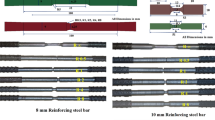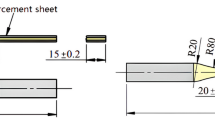Abstract
The use of FRP has been developed for flexural strengthening of reinforced concrete (RC) beams in recent years due to its advantages, such as ease of implementation, a slight change in cross-sectional dimensions, corrosion resistance, and increase in bearing capacity of the beam. Therefore, paying attention to technical considerations in applying FRP is crucial. This study intends to address two specific concerns. The first one is to determine the effect of the number of FRP layers on the improvement of mechanical and seismic properties in the flexural strengthening of RC beam and to specify the necessary numbers of FRP layers. The other consideration is to propose a new equation for FRP debonding stress and explain the behavior of FRP in tension after the occurrence of debonding failure. In this regard, reinforced concrete samples were prepared with zero, one, three, and five layers of GFRP, and then, four-point tests were performed on the samples. The results indicated an optimal number of GFRP layers that led to maximum mechanical and seismic properties in the flexural strengthening of beams. This study showed that the proposed model could not only estimate the debonding stress but also describe the behavior of GFRP after the debonding.












Similar content being viewed by others
Data availability
The datasets generated during and/or analysed during the current study are available from the corresponding author on reasonable request.
Abbreviations
- be :
-
Effective width of FRP in contact with concrete surface (mm)
- C:
-
Debonding constant value (N/mm)
- Ef :
-
Tensile modulus of elasticity of FRP (MPa)
- Fd :
-
Debonding force in FRP while debonding occurs (N)
- f’c :
-
Specified compressive strength of concrete (MPa)
- n:
-
Number of FRP layers
- tf :
-
Nominal thickness of one ply of FRP reinforcement (mm)
- \(\upvarepsilon\) :
-
Strain in FRP before debonding
- ɛfd :
-
Debonding strain in FRP reinforcements (%)
- ɛfu :
-
Fracture strain in FRP reinforcement (%)
- \(\sigma\) :
-
Stress in FRP before debonding
- σd :
-
Debonding stress in FRP while debonding occurs (MPa)
References
Achintha, M., & Burgoyne, C. (2013). Fracture energy of the concrete-FRP interface in strengthened beams. Engineering Fracture Mechanics., 110, 38–51. https://doi.org/10.1016/j.engfracmech.2013.07.016
ACI (American Concrete Institute). (2017). Guide for the design and construction of externally bonded FRP systems for strengthening concrete structures. ACI 440.2R–17. ACI.
Aljazaeri, Z. R., & Al-Jaberi, Z. (2021). Numerical study on flexural behavior of concrete beams strengthened with fiber reinforced cementitious matrix considering different concrete compressive strength and steel reinforcement ratio. International Journal of Engineering, Transactions a: Basics, 34(4), 796–802. https://doi.org/10.5829/IJE.2021.34.04A.05
Aram, M. R., Czaderski, C., & Motavalli, M. (2008). Debonding failure modes of flexural FRP-strengthened RC beams. Composites, Part b: Engineering, 39, 826–841. https://doi.org/10.1016/j.compositesb.2007.10.006
ASCE 41. (2006). Seismic Rehabilitation of Existing Buildings. ASCE.
ASCE 41. (2013). Seismic Evaluation and Retrofit of Existing Buildings. ASCE.
ASTM C150–07. (2007). Standard Specification for Portland Cement. ASTM International.
ASTM C39, C 39M. (2018). Standard Test Method for Compressive Strength of Cylindrical Concrete Specimens. ASTM International.
ASTM C78-22. (2022). Standard Test Method for Flexural Strength of Concrete (Using Simple Beam with Third-Point Loading). ASTM International.
Bilotta, A., Faella, C., Martinelli, E., & Nigro, E. (2013). Design by testing procedure for intermediate debonding in EBR FRP strengthened RC beams. Engineering Structures, 46, 147–154. https://doi.org/10.1016/j.engstruct.2012.06.031
Bykov, A. A., & Kalugin, A. V. (2013). New model for evaluation of FRP debonding strain for Russian Design Code. Advances in Materials Science and Engineering., 2013, 130162. https://doi.org/10.1155/2013/130162
CECS 146 (China Association for Engineering Construction Standardization). (2003). Technical Specification for Strengthening Concrete Structure with Carbon Fiber Reinforced Polymer Laminate. China Planning Press.
Ceroni, F., Pecce, M., Matthys, S., & Taerwe, L. (2008). Debonding strength and anchorage devices for reinforced concrete elements strengthened with FRP sheets. Journal of Composites-Part B, 39(3), 429–441. https://doi.org/10.1016/j.compositesb.2007.05.002
CNR-DT200 R1. (2012). Guide for the Design and Construction of Externally Bonded FRP Systems for Strengthening Existing Structures. NRC.
Elsanadedy, H. M., Abbas, H., Al-Salloum, Y. A., & Almusallam, T. H. (2014). Prediction of intermediate crack debonding strain of externally bonded FRP laminates in RC beams and one-way slabs. Journal of Composites for Construction, 18(5), 04014008. https://doi.org/10.1061/(ASCE)CC.1943-5614.0000462
Eurocode 2. (2004). Design of concrete structures, Part 1-1: General rules and rules for buildings. CEN, Brussels, EN 1992-1-1.
JSCE (Japan Society of Civil Engineers). (2007). Recommendations for upgrading of concrete structures with use of continuous fiber sheets. JSCE Concrete Engineering Series, 41, 31–34.
Kent, D. C., & Park, R. (1971). Flexural members with confined concrete. ASCE Journal of the Structural Engineering., 97(ST7), 1969–1990.
Li, G., Zhang, A., & Guo, Y. (2013). Debonding-related strain limits for externally bonded FRP sheets in flexurally strengthened reinforced concrete beams. The Open Civil Engineering Journal, 7, 58–67. https://doi.org/10.2174/1874149520130517002
Lu, X. Z. (2004). Studies of FRP-concrete interface. Ph.D. thesis, Tsinghua Univ., Beijing.
Lu, X. Z., Teng, J. G., Ye, L. P., & Jiang, J. J. (2007). Intermediate crack debonding in FRP-strengthened RC beams: FE analysis and strength model. Journal of Composites for Construction, 11(2), 161–174. https://doi.org/10.1061/(ASCE)1090-0268(2007)11:2(161)
Meier, U., & Kaiser, H. (1991). Strengthening of structures with CFRP Laminates, Advanced Composite Materials in Civil Engineering Structures. ASCE Specialty Conference, 224–232.
Microsoft Excel. (2019). Spreadsheet software programs.
Moein, R. S., & Tasnimi, A. A. (2016). An analytical model for FRP debonding in strengthened RC beams under monotonic and cyclic loads. International Journal of Concrete Structures and Materials., 10, 499–511. https://doi.org/10.1007/s40069-016-0172-5
Razaqpur, A. G., Lamberti, M., & Ascione, F. (2020). Debonding evolution in nonlinear FRP-retrofitted RC beams with cohesive interface. Composite Structures, 236, 111858. https://doi.org/10.1016/j.compstruct.2020.111858
Ritchie, A., Thomas, D. A., Lu, L. W., & Connelly, G. M. (1991). External reinforcement of concrete beams using fiber reinforced plastics. ACI Structural Journal, 88(4), 490–500.
Said, H., & Wu, Z. (2008). Evaluating and proposing models of predicting IC debonding failure. Journal of Composites for Construction., 12, 284–299. https://doi.org/10.1061/(ASCE)1090-0268(2008)12:3(284)
Sharif, A., Al-Sulaimani, G. J., Basunbul, I. A., Baluch, M. H., & Ghaleb, B. N. (1994). Strengthening of initially loaded reinforced concrete beams using FRP plates. ACI Structural Journal, 91(2), 160–168.
Taleb Obaidat, Y., Heyden, S., & Dahlblom, O. (2010). The effect of CFRP and CFRP/concrete interface models when modeling retrofitted RC beams with FEM. Composite Structures, 92, 1391–1398. https://doi.org/10.1016/j.compstruct.2009.11.008
Teng, J. G., Chen, J. F., Smith, S. T., & Lam, L. (2002). FRP strengthened RC structures. Wiley.
Teng, J. G., Lu, X. Z., Ye, L. P., & Jiang, J. J. (2004). Recent research on intermediate crack induced debonding in FRP strengthened RC beams. In: Proceedings of the 4th international conference on advanced composite materials in bridges and structures. Calgary, Alberta, Canada.
Teng, J. G., Smith, S. T., Yao, J., & Chen, J. F. (2003). Intermediate crack-induced debonding in RC beams and slabs. Construction and Building Materials, 17, 447–462. https://doi.org/10.1016/S0950-0618(03)00043-6
TR55. (2004). Design guidance for strengthening concrete structures using fibre composite materials. Concrete Society Technical Rep. 55 (2nd ed.). Camberley.
Acknowledgements
The authors would like to sincerely thank the contribution of Mr. Borjali Darvishvand for his collaboration in editing the article and Mr. Yavari for arranging the mechanical testing facilities at the laboratory of Building and Concrete Industry Research Center in Qazvin Azad University, Iran.
Funding
The authors have not disclosed any funding.
Author information
Authors and Affiliations
Contributions
Seiyed Ali Haj Seiyed Taghia: Supervision, Approval of the manuscript, Analysis and/or interpretation of data, Reviewing and Editing Hamid Reza Darvishvand: Data curation, Analysis and/or interpretation of data, Software, Original draft preparation, Reviewing and Editing Mostafa Maleki: Conception and methodology of study, Investigation, Resources, Analysis and/or interpretation of data
Corresponding author
Ethics declarations
Conflict of interest
No conflict of interest exits in the submission of this manuscript, and the manuscript was approved by all authors for publication.
Ethical approval
The authors declare that the research was conducted according to the ethical standards.
Consent for publication
The author would like to declare on behalf of all the co-authors that the work described is original research that has not been published previously, and not under consideration for publication elsewhere, in whole or in part. All the authors listed have approved the manuscript that is enclosed.
Additional information
Publisher's Note
Springer Nature remains neutral with regard to jurisdictional claims in published maps and institutional affiliations.
Appendices
Appendix A
Moment–curvature procedure in Excel program
First step: Geometry and properties

This information is tabulated in Tables
6,
7,
8,
9.
Second step: Analysis

Figure
13 illustrates the analysis procedure to generate a moment–curvature curve.
Appendix B
Table
10 represents the material properties and technical specification of concrete and GFRP used to calculate debonding strain for proposed model and other references (Table
11).
Rights and permissions
Springer Nature or its licensor (e.g. a society or other partner) holds exclusive rights to this article under a publishing agreement with the author(s) or other rightsholder(s); author self-archiving of the accepted manuscript version of this article is solely governed by the terms of such publishing agreement and applicable law.
About this article
Cite this article
Taghia, S.A.H.S., Darvishvand, H.R. & Maleki, M. Optimization and a new constitutive equation for RC beam strengthened by FRP. Asian J Civ Eng (2024). https://doi.org/10.1007/s42107-024-01042-8
Received:
Accepted:
Published:
DOI: https://doi.org/10.1007/s42107-024-01042-8





